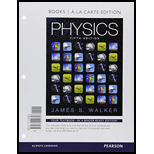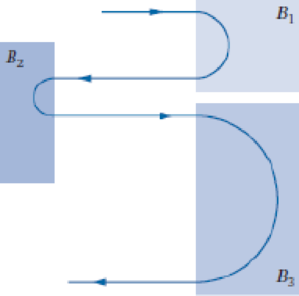
Concept explainers
CE A proton follows the path shown in Figure 22-56 as it moves through three regions with different uniform magnetic fields, B1, B2, and B3. In each region the proton completes a half-circle, and the magnetic field is perpendicular to the page. (a) Rank the three fields in order of increasing magnitude. Indicate ties where appropriate. (b) Give the direction (into or out of the page) for each of the fields.
Figure 22-56 Problems 71 and 72

Want to see the full answer?
Check out a sample textbook solution
Chapter 22 Solutions
Physics, Books a la Carte Plus Mastering Physics with Pearson eText -- Access Card Package (5th Edition)
Additional Science Textbook Solutions
Applications and Investigations in Earth Science (9th Edition)
Genetic Analysis: An Integrated Approach (3rd Edition)
Cosmic Perspective Fundamentals
College Physics: A Strategic Approach (3rd Edition)
Physics for Scientists and Engineers: A Strategic Approach, Vol. 1 (Chs 1-21) (4th Edition)
Introductory Chemistry (6th Edition)
- 3 Consider a ball sliding down a ramp as shown above. The ball is already in motion at the position 1. Which direction best approximates the direction of instantaneous velocity vector V when the object is at position 3?arrow_forwardNo chatgpt plsarrow_forwardA car in a roller coaster moves along a track that consists of a sequence of ups and downs. Let the x axis be parallel to the ground and the positive y axis point upward. In the time interval from t 0 tot = = 4s, the trajectory of the car along a certain section of the track is given by 7 = A(1 m/s)ti + A [(1 m/s³) t³ - 6(1 m/s²)t²]ĵ where A is a positive dimensionless constant. At t car ascending or descending? = 2.0 S is the roller coaster Ascending. Descending.arrow_forward
- Children playing in a playground on the flat roof of a city school lose their ball to the parking lot below. One of the teachers kicks the ball back up to the children as shown in the figure below. The playground is 6.10 m above the parking lot, and the school building's vertical wall is h = 7.40 m high, forming a 1.30 m high railing around the playground. The ball is launched at an angle of 8 = 53.0° above the horizontal at a point d = 24.0 m from the base of the building wall. The ball takes 2.20 s to reach a point vertically above the wall. (Due to the nature of this problem, do not use rounded intermediate values-including answers submitted in WebAssign-in your calculations.) (a) Find the speed (in m/s) at which the ball was launched. 18.1 m/s (b) Find the vertical distance (in m) by which the ball clears the wall. 0.73 ✓ m (c) Find the horizontal distance (in m) from the wall to the point on the roof where the ball lands. 2.68 m (d) What If? If the teacher always launches the ball…arrow_forwardIt is not possible to see very small objects, such as viruses, using an ordinary light microscope. An electron microscope can view such objects using an electron beam instead of a light beam. Electron microscopy has proved invaluable for investigations of viruses, cell membranes and subcellular structures, bacterial surfaces, visual receptors, chloroplasts, and the contractile properties of muscles. The "lenses" of an electron microscope consist of electric and magnetic fields that control the electron beam. As an example of the manipulation of an electron beam, consider an electron traveling away from the origin along the x axis in the xy plane with initial velocity ₁ = vi. As it passes through the region x = 0 to x=d, the electron experiences acceleration a = ai +a, where a and a, are constants. For the case v, = 1.67 x 107 m/s, ax = 8.51 x 1014 m/s², and a = 1.50 x 10¹5 m/s², determine the following at x = d = 0.0100 m. (a) the position of the electron y, = 2.60e1014 m (b) the…arrow_forwardNo chatgpt plsarrow_forward
- need help with the first partarrow_forwardA ball is thrown with an initial speed v, at an angle 6, with the horizontal. The horizontal range of the ball is R, and the ball reaches a maximum height R/4. In terms of R and g, find the following. (a) the time interval during which the ball is in motion 2R (b) the ball's speed at the peak of its path v= Rg 2 √ sin 26, V 3 (c) the initial vertical component of its velocity Rg sin ei sin 20 (d) its initial speed Rg √ sin 20 × (e) the angle 6, expressed in terms of arctan of a fraction. 1 (f) Suppose the ball is thrown at the same initial speed found in (d) but at the angle appropriate for reaching the greatest height that it can. Find this height. hmax R2 (g) Suppose the ball is thrown at the same initial speed but at the angle for greatest possible range. Find this maximum horizontal range. Xmax R√3 2arrow_forwardAn outfielder throws a baseball to his catcher in an attempt to throw out a runner at home plate. The ball bounces once before reaching the catcher. Assume the angle at which the bounced ball leaves the ground is the same as the angle at which the outfielder threw it as shown in the figure, but that the ball's speed after the bounce is one-half of what it was before the bounce. 8 (a) Assuming the ball is always thrown with the same initial speed, at what angle & should the fielder throw the ball to make it go the same distance D with one bounce (blue path) as a ball thrown upward at 35.0° with no bounce (green path)? 24 (b) Determine the ratio of the time interval for the one-bounce throw to the flight time for the no-bounce throw. Cone-bounce no-bounce 0.940arrow_forward
 Physics for Scientists and Engineers: Foundations...PhysicsISBN:9781133939146Author:Katz, Debora M.Publisher:Cengage Learning
Physics for Scientists and Engineers: Foundations...PhysicsISBN:9781133939146Author:Katz, Debora M.Publisher:Cengage Learning Principles of Physics: A Calculus-Based TextPhysicsISBN:9781133104261Author:Raymond A. Serway, John W. JewettPublisher:Cengage Learning
Principles of Physics: A Calculus-Based TextPhysicsISBN:9781133104261Author:Raymond A. Serway, John W. JewettPublisher:Cengage Learning College PhysicsPhysicsISBN:9781938168000Author:Paul Peter Urone, Roger HinrichsPublisher:OpenStax College
College PhysicsPhysicsISBN:9781938168000Author:Paul Peter Urone, Roger HinrichsPublisher:OpenStax College
 Physics for Scientists and Engineers with Modern ...PhysicsISBN:9781337553292Author:Raymond A. Serway, John W. JewettPublisher:Cengage Learning
Physics for Scientists and Engineers with Modern ...PhysicsISBN:9781337553292Author:Raymond A. Serway, John W. JewettPublisher:Cengage Learning Physics for Scientists and Engineers, Technology ...PhysicsISBN:9781305116399Author:Raymond A. Serway, John W. JewettPublisher:Cengage Learning
Physics for Scientists and Engineers, Technology ...PhysicsISBN:9781305116399Author:Raymond A. Serway, John W. JewettPublisher:Cengage Learning





